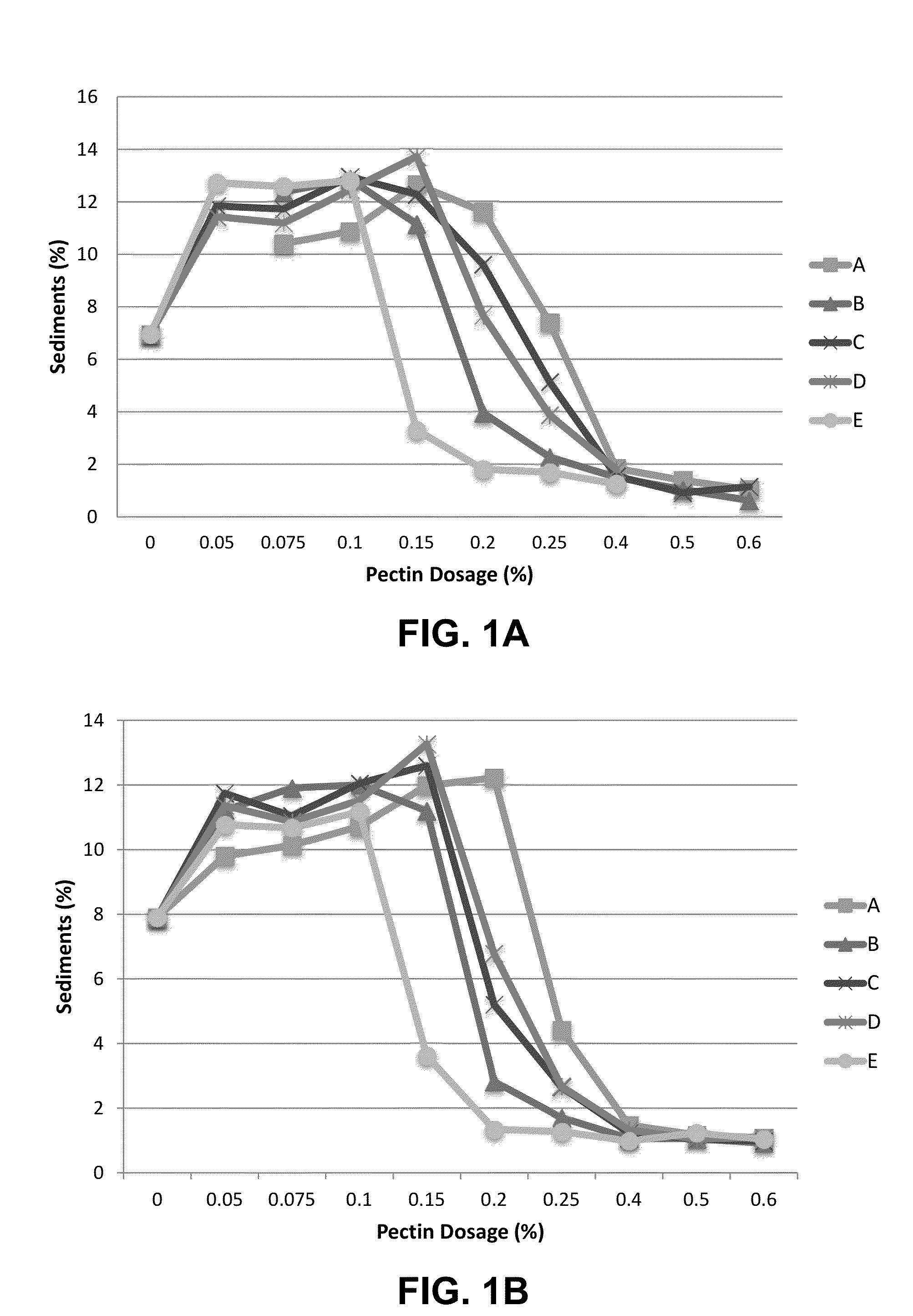Process for Preparing a Stabilized Protein Suspension
a technology of protein suspension and stabilized protein, which is applied in the field of process for preparing stabilized protein suspension, can solve the problems of incomplete rationalization of functional behavior and limited by the current scientific understanding, and manufacturers have used hm pectin to address these issues with only limited success, and hm pectin may also adversely affect the rheology of amd solution
- Summary
- Abstract
- Description
- Claims
- Application Information
AI Technical Summary
Benefits of technology
Problems solved by technology
Method used
Image
Examples
example 1
Yoghurt Drinks Stabilized with One Pectin Sample Present in a Range of Concentrations, Five Qualities of Water for the Pectin Solution, No Addition of Phosphate
[0046]Pectin solutions were prepared according to Table 1a and as described above. The following pectins were used for the experiments:[0047]Pectin (PB44828 / YM115LL) having a DM of 70.20, IV (intrinsic viscosity) of 6.0, CS99 (calcium sensitivity) of 255, and YOG3C (strength) of 188[0048]Pectin (PP Trial 3 N5) having a DM of 67.52, IV of 6.23, CS99 of 668, and YOG3C of 169
[0049]CS99 is a metric used to characterized calcium sensitivity and is determined by the viscosity (in this case made using a Brookfield viscosmeter) of an aqueous solution of pectin and pH-buffering salts and a calcium salt. Higher values mean higher calcium sensitivity while the least calcium sensitive samples may be as low as about 10.
[0050]Commercial qualities of pectin are typically standardized to 115 grades YOG or 150 grades YOG by dilution with sucr...
example 2
Preparation of Yoghurt Drinks Stabilized with Two Pectin Samples Present in a Range of Concentrations, Two Qualities of Water Used for the Pectin-Solutions, and Three Levels of Phosphate Dosing (One of Which Being No Addition) for These Solutions
[0056]Pectin solutions were prepared according to Table 2a and as described above. Prototype milk drinks with diverse concentrations of pectin were prepared by blending 17% MSNF yoghurt and the pectin solution according to Table 2b and as described above. After homogenization, each drink was split into two parts, with measurement of sediment by centrifugation being evaluated with or without heat-treating the drink. A summary of the sediments obtained is provided in Table 2c (without heat treatment) and Table 2d (with heat treatment).
TABLE 2aSolution NamePectin typeWater typeSHMP (%)pH (25° C.)AYM 115 Ldeionized03.88BYM 115 Ldeionized203.97CYM 115 LLdeionized103.56DYM 115 LLdeionized203.61EYM 115 LLtap105.97FYM 115 LLtap206.01
TABLE 2bDeionize...
example 3
Four Levels of Phosphate (One of Which Being No Addition) Used for Pectin Solutions with Tap-Water. Phosphate Added During Pectin Manufacturing
[0062]Pectin samples with SHMP were prepared as explained described above to produce four samples: A (SHMP=0% w / w), B (SHMP=5.1% w / w), C (SHMP=9.8% w / w), and D (SHMP=18.15% w / w). Solutions of pectin samples A, B, C, and D were prepared according to Table 3a and otherwise as described above. Prototype milk drinks with diverse concentrations of pectin were prepared by blending 17% MSNF yoghurt and pectin solution according to Table 3b and as described above. After homogenization, each drink was split into two parts, with measurement of sediment by centrifugation being evaluated with or without heat-treating the drink. A summary of the sediments obtained is provided in Table 3c (without heat treatment) and Table 3d (with heat treatment).
TABLE 3aCalculatedAmount ofPhosphateCalcuatedtrue pectin%driedAmount(% ofSHMP ingum insaturationPhosphate-ofdr...
PUM
 Login to View More
Login to View More Abstract
Description
Claims
Application Information
 Login to View More
Login to View More - R&D
- Intellectual Property
- Life Sciences
- Materials
- Tech Scout
- Unparalleled Data Quality
- Higher Quality Content
- 60% Fewer Hallucinations
Browse by: Latest US Patents, China's latest patents, Technical Efficacy Thesaurus, Application Domain, Technology Topic, Popular Technical Reports.
© 2025 PatSnap. All rights reserved.Legal|Privacy policy|Modern Slavery Act Transparency Statement|Sitemap|About US| Contact US: help@patsnap.com


